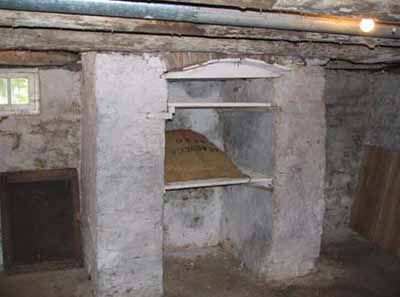Griffin House National Historic Site of Canada
Hamilton, Ontario

General view
© Agence Parcs Canada / Parks Canada Agency, M. D'Abramo, 2006.
Address :
733 Mineral Springs Road, Hamilton, Ontario
Recognition Statute:
Historic Sites and Monuments Act (R.S.C., 1985, c. H-4)
Designation Date:
2008-04-11
Dates:
-
1827 to 1827
(Construction)
-
1834 to 1888
(Significant)
-
1992 to 1994
(Significant)
Event, Person, Organization:
-
Underground Railroad
(Event)
-
Enerals Griffin
(Person)
-
Hamilton Conservation Authority
(Organization)
-
John Lawrason
(Architect)
Other Name(s):
-
Griffin House
(Designation Name)
-
Costello House
(Other Name)
Research Report Number:
2007-020, 1998-SUA Dec
Plaque(s)
Existing plaque: 733 Mineral Springs Road, Hamilton, Ontario
Built in 1827, this home is associated with Black settlement in British North America during the first half of the 19th century. Purchased in 1834 by Enerals Griffin, a Black immigrant from Virginia, it remained in his family for 154 years. More elaborate than most residences of Black settlers in this period and situated within a predominantly Euro-Canadian area rather than in an organized refugee community in southwestern Ontario, this house conveys the diversity of the Black settler experience. Griffin House is also a rare surviving example of residential vernacular architecture typical of Upper Canada in the early 19th century.
Description of Historic Place
Griffin House National Historic Site of Canada is a modest one-and-one-half-storey house located atop a hill overlooking the Dundas Valley in Ancaster Township, in what is now the City of Hamilton. Built around 1827, the dwelling is of simple Georgian-inspired design typical of a 19th-century Upper Canadian four-room house. It has a front-sloping gable roof, and is clad in unfinished horizontal clapboards. Official recognition refers to the building and the land surrounding the house where outside limits for archaeological excavations were surveyed and identified as “archaeologically sensitive.”
Heritage Value
Griffin House was designated a national historic site of Canada in 2007 because: the house, owned by Enerals Griffin, a Black immigrant from Virginia who settled here in 1834, is associated with Black settlement in British North America during the first half of the 19th century. It is also a rare surviving example of residential vernacular architecture typical in Upper Canada in the early 19th century; and, the house conveys the complexity of the Black experience: it is a more elaborate dwelling than was common among Black refugees, and it is situated within a predominantly Euro-Canadian community in south-central Ontario rather than a planned refugee settlement in south-western Ontario. The house remained in the family for 154 years.
A major influx of Black immigrants made their way to pre-Confederation Canada during the 19th century along the Underground Railroad to obtain freedom from enslavement and the restrictive laws for the Black population in the United States. Enerals Griffin was among the Black settlers who chose to come to Canada, arriving at Niagara with his wife in 1829. Griffin bought the former Lawrason house and fifty acres (202 342.8 metres squared) of land from George Hogeboom in 1834. Griffin House is a typical, but now rare surviving example of a four-room house found throughout Upper Canada in this period. It has undergone major restorations between 1922 and 1994 to return the house to its 1830-1850 appearance.
In addition to its architectural value, Griffin House is historically significant because it conveys the complexity of the Black experience in British North America during the early years of the Underground Railroad, in that it represents a more elaborate dwelling than was common among Black refugees. The location of Griffin House in Ancaster township (now the city of Hamilton) also contributes to the historical value of the site. Immigrants in the 19th century were attracted to the predominantly Euro-Canadian community for its labour market and agricultural potential instead of the planned refugee settlements in south-western Ontario. Griffin House represents the permanent, long-term settlement of Black immigrants in what is now Canada, for the house stayed in the family's possession through the generations until 1988, when it was sold to the Hamilton Conservation Authority.
Source: Historic Sites and Monuments Board of Canada, Minutes, July 2007.
Character-Defining Elements
Key elements contributing to the heritage value of this site include: the original location in Ancaster township in south central Ontario; the setting atop a small knoll overlooking the Dundas Valley; the simple Georgian-inspired design with a modest one-and-one-half storey frame and a two-bay front; the interior layout of the house, with two rooms upstairs, two rooms downstairs and a cellar; the surviving original features such as two fireplaces, cupboards, all doors and wide baseboard trim; the rubble stone foundation, front-sloping gable roof, and the original unfinished horizontal clapboard cladding preserved under subsequent layers added over the years; the classical details including returning eaves, corner boards, a central entrance and symmetrical openings; the integrity of any surviving or as yet unidentified archaeological remains which may be found within the site in their original placement and extent.